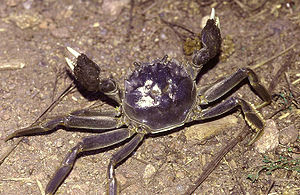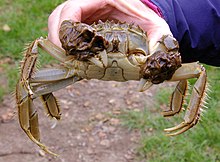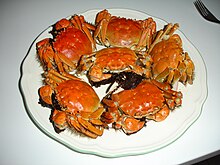Chinese mitten crab
| Chinese mitten crab | ||||||||||||
|---|---|---|---|---|---|---|---|---|---|---|---|---|

Chinese mitten crab ( Eriocheir sinensis ) |
||||||||||||
| Systematics | ||||||||||||
|
||||||||||||
| Scientific name | ||||||||||||
| Eriocheir sinensis | ||||||||||||
| Milne Edwards , 1853 |

The Chinese woolly crab ( Eriocheir sinensis ) is a species of crab originally native to China .
It was introduced to Europe at the beginning of the 20th century. In the native fauna of some rivers, the animal has now firmly established itself as a new citizen ( neozoon ) despite being combated by humans .
description
The crab got its name because the male animals in particular have thick “fur” on their claws, which makes the species unmistakable. The hairiness occurs less conspicuously in females and young animals. Their almost square back armor ( carapace ) can be up to 7.5 centimeters long (in exceptional cases even 10 centimeters). He hardly shows any size differences between the sexes. The total width including the long legs can be up to 30 centimeters; the leg length is twice the carapace width. The weight of adult animals is between 70 and 200, exceptionally up to 400 grams. The abdomen is handled like all crabs forward on the ventral side. This multi-limbed body part, known as the Malacostraca pleon , is narrow tongue-shaped in the males, and almost as wide as the carapace in the females. The back armor is olive green or brown in color with darker spots and finely serrated on the edge. There are also four sharply pointed saw teeth on each side of its front corners. The foremost pair of extremities is transformed into claw hands, which are more pronounced in the male than in the female. The four pairs of legs are long and flattened and have hairlines on the edges.
Way of life
Mitten crabs colonize larger rivers . There they live mainly nocturnal on the bottom and feed on aquatic plants , insect larvae , mussels , snails , smaller fish and carrion . In new studies and older surveys from the 1930s (summarized in), around three quarters of the food (up to 90% at most) consists of plant material and is mainly based on what is on offer. Mussels are preferred in order to cover their own lime needs with their shells. Fry as well as healthy and agile fish are not eaten.
Dwelling caves are being dug along the banks; but also under stones and in soft sediment the species seeks protection. In the meantime, she can stay on land for some time. As they grow, the crabs moult regularly by shedding their old armor. The new one has already been created and just needs to harden.
hikes
As an adult, the woolly crab lives in fresh water, but needs salty water for development, which is reached via reproductive migrations downstream (so-called catadromous migrations, as with eels ). With the start of the mating season in late summer, the adult animals migrate downstream to the sea. This migration can drag on for several months with daily performance between eight and twelve kilometers. The first in the tidal incoming mouths males fit in there from the females. After mating, the females migrate to the estuary area ( brackish water ), which is strongly influenced by salt, and spawn there within 24 hours. They carry the eggs under their pleon until shortly before the larvae hatch, attached to the pleopods. Very high egg numbers (approx. 250,000 to 900,000) are achieved per female. The wearing time is about four months. Then the females run back into the brackish water zone of the river mouth and release the hatched eggs into the water. Then the dams die; so they only reproduce once. The males do not return either.
A freely swimming larval stage , the so-called zoea , hatches from the egg . After five moults, a larval stage living on the ground, the megalopa, is reached, which after moulting transforms into a young crab about three millimeters in size, which anatomically corresponds to the adult animal. The older larval stages in particular require a higher salt content in the water and cannot survive in pure fresh water, whereas adult crabs can do this without problems. The development never takes place in the open sea, but always in the brackish water of the estuaries and estuaries. The young crabs that develop from the larvae migrate back up the rivers in spring (April / May) while they get bigger and bigger. However, it takes one and a half to two years to reach the hiking size. Before the ascent, the animals gather in the deeper water and then hike upwards as one. The effort against the current takes several years, for example at the Calbe weir (at the mouth of the Saale into the Elbe) most of the young animals caught were three years old. The migration speed of young animals was determined to be around one kilometer per day, in older animals up to three kilometers, which results in an annual output of around 200 to 250 km. Larger obstacles such as B. Weirs are bypassed on land if necessary, even vertical concrete walls can be climbed over.
At around five to six years of age, the mitten crabs reach sexual maturity and take part in the reproductive migration to the sea.
Occurrence
The original home of the mitten crabs is in the East China latitudes approximately between Korea and the province of Fujian in the amount of Taiwan - especially the estuary of the river Yangtze .
After Europe , they were probably at the beginning of the 20th century as larvae with the ballast water introduced by merchant ships. In 1912 the species was first detected in the Aller . In the meantime, it spread invasively in several bursts, especially in the rivers Elbe , Weser , Ems and Rhine and their tributaries, which flow into the North Sea . The Baltic Sea tributaries Oder and Vistula were also settled in 1929/1930 (before the Rhine), although the animals in the Baltic Sea cannot reproduce due to insufficient salt content, but must rather migrate to the Kattegat (even here, reproduction was only proven in 2011 ). In the meantime, the northern end of the Gulf of Bothnia has also been reached by the animals, although in isolated occurrences it is not always clear whether reproduction takes place. Even far upstream, for example in Basel , Dresden or Prague , woolly crabs have been sighted. The Berlin waters are populated via the Havel and the shipping canals. The great French river systems of the Seine, Loire and Gironde, from where it reached the artificial lagoons of the Mediterranean coast by migration via canals, as well as the Thames in Great Britain (known since the 1930s) and in the Scottish Clyde (first recorded in the June 2014). The species has been sighted several times in the Mediterranean and its tributaries, but so far it seems to be rare. After modeling the climatic requirements ( niche model ), they can colonize almost all of Europe. Other occurrences have been proven almost worldwide, with further spreading via ballast water. So about 15 years ago the San Francisco Bay (North America) was settled (according to genetic markers from Europe, not directly from China). This ability to spread has put the species on the list of the “100 worst non-indigenous species”. The animals tolerate different salt concentrations, such as those found in the tidal zones of the river lower reaches, very well. The temperatures in German estuaries hardly differ from those in north-east Chinese waters. Thanks to sewage treatment plants and increased environmental awareness, the water quality in the major rivers, which has improved significantly in recent years, is also favoring further expansion in Central Europe. In the Middle Elbe the crab population went down e.g. B. fell sharply after the first mass development in the 1930s at the beginning of the 1950s, reached a low point in 1960/70 and rose rapidly again at the beginning of the 1990s. In addition, cyclical population fluctuations with a period of approx. Twelve years are striking, which may be related to temperature and salinity fluctuations in the larval habitats.
Neozoa problem, economic damage and benefit
Since the first appearance of the species has been feared that they as omnivores ( omnivores might occur) in competition for food among other things, also used by humans fish species. Investigations and estimates made in the 1930s when the species first appeared in masses, however, did not reveal any evidence of population decline. Food competition would be possible with very high occurrences in nutrient-poor waters such as the Middle Elbe. Otherwise there is direct competition mainly from species of crayfish. In the larger river systems of Germany this applies almost exclusively to the neozoic crayfish ( Orconectes limosus ) (introduced from America ). Other ecological damage caused by the species has not yet been proven.
Riverside structures and dams are occasionally affected by the massive digging of hollow passages and can collapse and clog drainages , but this affects almost exclusively the tidal area. Even among anglers and fishermen, woolly crabs are unpopular: When fishing with baitfish on the bottom, the animals nibble the bait off the hook within a short time without the angler noticing. They also cut the line with their sharp claws to get the bait. When fishing for fish traps, they attack and eat fish that have been caught. Fish trap entrances can become clogged by the animals, making them impossible to use. As a result, major economic damage occurs primarily in the eel fishery. In addition, woolly crabs also cut the nets.
It was only proven in 2014 that the Chinese mitten crab is also a vector of crab plague , a parasitic fungal disease that primarily affects crayfish .
The Chinese mitten crab has been added to the “List of Unwanted Species” for the European Union .
Combat
Wollhand crabs - especially the soft, molted animals - are specifically sought and eaten by eels , perches , alandas and other fish. The only bird species that the species occasionally catches in higher proportions is the gray heron , in which it can make up up to 20% of the food in individual colonies. In addition to the so-called burn mark disease, the woolly crab is also attacked by the cancer plague pathogen , which, however, only causes minor damage.
In 1935 500 tons of the species were caught in the Elbe; In 1936 people all over northern Germany collected over 20 million young crabs by hand. Trapping systems for migrating young crabs on weirs were in operation from the 1930s to the 1950s. But only the rapid pollution of water in the middle of the 20th century led to a temporary collapse of the population in the Elbe, for example . Special fishing gear has been developed to combat the increasing number of woolly crabs, but with questionable results. While the crabs migrate, tons of animals are collected with the help of automatic trapping systems at weirs and sluices that act as barriers - for example the fish ladders at the Elbe barrage near Geesthacht - and sent for recycling. Fishing clubs also carry out appropriate fishing activities.
At present (as of 2010) attempts are being made in Spain to prevent the species from settling in the Guadalquivir estuary, where it has so far been observed sporadically. The success remains to be seen.
Recovery
In China, the homeland of origin, the species is now being bred in aquaculture . The annual harvest in 2000 was around 200,000 tons. The commercial value of a single good crab can reach $ 40. In some cases, the species is already being fished commercially in a targeted manner in the Lower Elbe.
In Chinese cuisine , crabs are a popular delicacy. There are also restaurants in Germany that offer the animals, especially when they are migrating. In addition, they are offered on Asian markets . There is a breeding facility in the Netherlands . For preparation, the crabs are tied with strings to prevent the tasty juice from leaking out during cooking. Then they are cooked in steam.
Because the large number of woolly crabs is not consumed by European gastronomy, instead of culinary use, there is primarily a material use, for example for chitosan production and biogas production. Chitosan is a sought-after raw material that z. B. is used in wastewater treatment, in medicine (sutures), in agriculture (seed treatment) and in the food industry. Woolly crabs are also used as bait by anglers. In the meantime, the species is even supposed to be delivered from Europe to China, the country of origin, in order to support the stocks there, which have in some cases strongly declined due to environmental pollution, overfishing and dam projects .
In the aquarium
The Chinese mitten crab is an interesting foster animal in the aquarium . For species-appropriate care, it needs a spacious aquaterrarium with a cover that offers sufficient hiding places under or between stone structures. If the aquaterrarium does not offer enough space or hiding places, the animals are incompatible with one another. The temperature in the aquaterrarium should be between 18 and 20 degrees Celsius. The water should have a hardness of 10 to 20 ° dGH and a pH value of 7.5 to 8. Adding a teaspoon of sea salt to 100 liters of water contributes to the wellbeing of the animals.
Chinese woolly crabs are fed with fish meat as well as insect larvae and small crustaceans. You can also get used to high-quality flake food.
literature
- Heiko Bellmann , Gerhard Maier: Spiders, crabs, millipedes - European arthropods (without insects). (= Steinbach's nature guide. Part 9). Mosaik-Verlag, Munich 1991, ISBN 3-570-06450-6 .
- Ernst Paul Dörfler : Miracle of the Elbe - biography of a river. Stekovics, Halle an der Saale 2000, ISBN 3-932863-40-2 .
- Hans Gonella: Crabs, crabs and prawns in the freshwater aquarium . bede-Verlag, Ruhmannsfelden 1999, ISBN 3-931792-87-0 .
- É. Veilleux, Y. de Lafontaine: Biological Synopsis of the Chinese Mitten Crab (Eriocheir sinensis). (= Canadian Manuscript Report of Fisheries and Aquatic Sciences. No. 2812). Fisheries and Oceans Canada Science Branch, Pacific Region, Pacific Biological Station Nanaimo, BC, OCLC 473478492 .
Web links
Individual evidence
- ↑ E. Fladung: Studies on the stock regulation and utilization of the Chinese woolly crab (Eriocheir sinensis) with special consideration of the fishing conditions in the Elbe-Havel area (= publications of the Institute for Inland Fisheries eV Potsdam-Sacrow . Volume 5). 2000 (download can be found here).
- ↑ K. Anger: Effects of temperature and salinity on the larval development of the Chinese middle crab Eriocheir sinensis (Decapoda: Grapsidae). In: Marine Ecology Progress Series. Vol. 72, 1991, pp. 103-110.
- ↑ Thurid Otto, Dirk Brandis: First evidence of Eriocheir sinensis reproduction from Schleswig-Holstein, Northern Germany, western Baltic Sea. In: Aquatic Invasions. Volume 6, Supplement 1, 2011, pp. 65-69, doi: 10.3391 / ai.2011.6.S1.015 .
- ^ 'Hairy crab' threat to Scottish fish. In: BBC News. September 25, 2014, accessed September 25, 2014 .
- Jump up ↑ Leif-Matthias Herborg, Deborah A. Rudnick, Yang Siliang, David M. Lodge, Hugh J. MacIsaac: Predicting the Range of Chinese Mitten Crabs in Europe. In: Conservation Biology. Volume 21, No. 5, 2007, pp. 1316-1323, doi: 10.1111 / j.1523-1739.2007.00778.x .
- ↑ S. Lowe, M. Browne, S. Boudjelas: 100 of the world's worst invasive alien species: a selection from the Global Invasive Species Database . World Conservation Union / ISSG, Auckland, New Zealand 2000.
- ↑ A. Panning: The Chinese woolly crab (= Die Neue Brehm-Bücherei . Volume 70). Academic publishing company Geest & Portig KG, Leipzig 1952.
- ^ Anne Schrimpf, Thomas Schmidt, Ralf Schulz: Invasive Chinese middle crab (Eriocheir sinensis) transmits crayfish plague pathogen (Aphanomyces astaci) . In: Aquatic Invasions 9 (2), 2014, doi: 10.3391 / ai.2014.9.2.09 , pp. 203-209.
- ↑ List of Invasive Alien Species of Union Concern. (PDF) Retrieved July 15, 2016 (PDF; 333 kB).
- ↑ Juan Garcia-de-Lomas, Elías D. Dana, Javier López-Santiago, Rubén González, Guillermo Ceballos, Fernando Ortega: Management of the Chinese middle crab, Eriocheir sinensis (H. Milne Edwards, 1853) in the Guadalquivir Estuary (Southern Spain). In: Aquatic Invasions. Volume 5, Issue 3, 2010, pp. 323-330, doi: 10.3391 / ai.2010.5.3.11 .
- ↑ Paul F. Clark: The Commercial Exploitation of the Chinese Mitten Crab Eriocheir sinensis in the River Thames, London: Damned if We Don't and Damned if We Do. In: BS Galil et al. (Ed.): In the Wrong Place - Alien Marine Crustaceans: Distribution, Biology and Impacts Invading Nature (= Springer Series in Invasion Ecology . Volume 6, Part 4). 2011, pp. 537-580, doi : 10.1007 / 978-94-007-0591-3_19 .
- ↑ Helmut Höge: The woolly crab . In: The daily newspaper: taz . January 2, 2019, ISSN 0931-9085 , p. 26–27 ePaper 22–23 North ( taz.de [accessed on March 15, 2019]).


